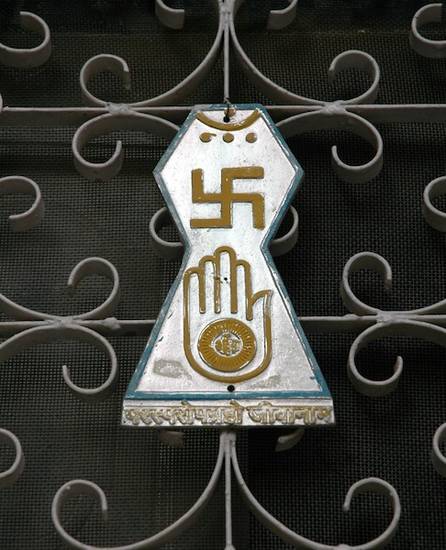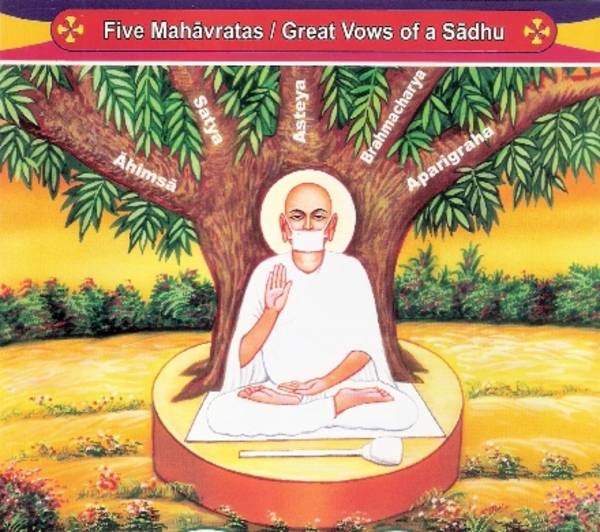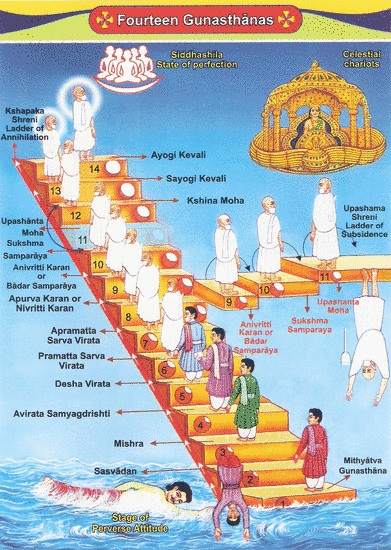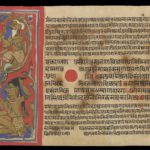Article: The ‘Three Gems’
The ‘three gems’ or ‘three jewels’ – ratna-traya – is the metaphorical expression often used for the triplet of correct faith, correct knowledge and correct conduct. Together, these form the Jain doctrine and are necessary to reach liberation from the cycle of rebirths, which is the basic purpose of the Jain faith. This is the path taught by the Jinas.
Since the three gems are fundamental to the Jain faith, they are discussed in many Jain writings. Early references, such as the Tattvārtha-sūtra and Uttarādhyayana-sūtra, describe the group of three concepts in detail but do not refer to them as the ‘three gems’. Only in later texts does the term appear. Similar groups of three or four concepts are found in other religions, including Buddhism and Christianity, but there is no influence on the Jain triplet. Perhaps a group of related key concepts is easier to remember than separate principles.
The three jewels of right faith, right knowledge and right conduct can be defined as summaries of the Jain faith. Other principles and beliefs develop logically from the triplet, from which the various practices of Jainism arise. For example, samyag-darśana – right faith – is the first necessary condition of being a Jain because it entails fully accepting the Jain concept of the universe and reality. Only once an individual embraces right faith can he or she begin to make spiritual progress by accepting the other two gems and the principles and practices they imply.
This is why the three gems are always stated in this order and grouped together. The triplet helps Jains progress up the guṇa-sthāna – 14 stages of spiritual progression – towards salvation. Only when all three are perfectly realised does the soul reach the final stage and become liberated from the cycle of rebirth.
The ‘conventional’ and ‘absolute’ points of view in Jain thought distinguish between external ritual and inner self-realisation as ways of attaining liberation. Considered in this way, the three gems are conventional, since they form a means to an end.
The triplet is so fundamental to Jainism that it can be detected in all areas of religious practice. It can be seen in important symbols of the faith, such as the Jain flag and the svastika pattern frequently created as part of worship. The focus of a particular ritual among the sect of the Digambaras, it is accompanied by special mantras and hymns.
A ‘fourth gem’ makes its appearance early in Jain literature. Austerity – tapas – destroys karma and is thus vital in achieving spiritual emancipation. A very significant principle in Jainism, austerity is often practised as fasting and is believed to be vital to spiritual progress. Even though it is not classed formally as the ‘fourth jewel’, it is therefore commonly included in the concept of the ratna-traya.
Fundamental triplet
Jains strive to reach liberation from the cycle of rebirth and the triplet of the ‘three gems’ guides them on the journey. As the basis of Jain doctrine, the idea of the three gems is found in many written sources. Several religions have the notion of a summary or key principles of a religious faith distilled into three or four items that are considered together.
The three gems of Jainism are:
- correct faith – samyag-darśana
- correct knowledge – samyag-jñāna
- correct conduct – samyag-cāritra or samyak-cāritra.
The epithet samyak or samyag applied to each of the terms is usually translated as ‘correct’ or ‘right’. Both are acceptable. ‘Right’ probably looks a stronger term but it is not out of place, as mithyā, the opposite Indian term, means ‘wrong’.
These three concepts are vital for spiritual progression and are deeply intertwined with the principles and practices of the Jain faith.
Sources
The triplet of right faith, right knowledge and right conduct is at the basis of Jainism, paving the road to liberation from the cycle of rebirths. It is defined as such in the earliest Jain sources.
Well-known early examples of references to the three gems are:
- chapter 28 of the Uttarādhyayana-sūtra, one of the Śvetāmbara canonical scriptures written in Ardhamāgadhī Prakrit
- the very first aphorism of the Tattvārtha-sūtra.
Indeed, the whole of chapter 28 of the Uttarādhyayana-sūtra discusses ‘the road to final deliverance’ (Jacobi’s translation 1895: 152) and is one of the central sources on the topic. Interestingly, it includes ‘austerities’ – tapas – as a fourth element. This relates to the third gem, which is concerned with behaviour.
Undoubtedly the best-known reference to the three gems is the first sūtra in the Tattvārtha-sūtra. It states that:
Right faith, right knowledge and right conduct are the way to liberation
samyag-darśana-j̄ñāna-cāritrāṇi mokṣa-mārgaḥ
Tattvārtha-sūtra 1.1
This text is generally agreed among all sects to be the fundamental statement of Jain belief. The entire Tattvārtha-sūtra elaborates these three notions as the path to liberation.
In both these texts, however, there is no generic term to refer to the triplet and the term ‘three gems’ is not used. The historical development that led to this term needs further investigation.
One of the most famous references to and definitions of the ‘three gems’ – Sanskrit ratna-traya – is found at the outset of an important Śvetāmbara treatise written much later. The Yoga-śāstra, written by the 12th-century Jain monk and teacher Hemacandra, states that:
Liberation is the foremost among the four goals [of human objectives], the means of which is yoga. This [yoga, which also is designated] the three jewels, consists of [correct] knowledge, faith and conduct. Here [in this Jaina system], the wise define correct knowledge as the understanding, either in detail or in brief, of the [seven] principles as they really are. [To have] a liking for [these] principles, explained by the Jina, is the definition of true faith. That [faith] arises either spontaneously, or [indirectly] through the knowledge of [one’s] teacher. [Proper] conduct is defined as the abandonment of all blameworthy activities. That [proper conduct] has been described as fivefold because of the division into the vow of non-harm and so forth.
Yoga-śāstra 1.15-18
Qvarnström’s translation 2012: 26-27
This passage first refers to the general Hindu conception, which traditionally counts four ‘human objectives’ – puruṣārtha. They are:
- religious conduct – dharma
- material goals, such as earning money – artha
- satisfaction of worldly desires and pleasures – kāma
- liberation from the cycle of rebirths – mokṣa.
In the Jain context, liberation is the most important. The means to reach it is yoga, which here literally means ‘conjunction, combination’. The combination of the three Jain terms is known as the ‘three gems’ or ‘three jewels’ in common Jain parlance today.
Other religions
Similar ideas to the ‘three jewels’ can be found in other religious faiths as summaries of key principles or elements. For example, Buddhism uses ‘the three gems’ metaphorically to refer collectively to the:
But there is no connection with or influence from one tradition on the other in this usage.
Similarly, right belief, right knowledge and right conduct are sometimes equated with ‘the holy Trinity’ (Jaini 1923: 23) in Christianity when the author wants to underline that Jainism is not peculiar.
Definitions
The three jewels cover the central Jain principles.
Encompassing faith, knowledge and action, the concept embraces the different stages of progress towards liberation.
Each gem naturally leads to the next one, although the three elements are important at all spiritual levels.
Right faith
This crucial condition is the bedrock of being a member of the Jain faith. It requires that an individual accepts basic Jain beliefs, from which other principles flow. Samyag-darśana – ‘right faith’ – is defined as the:
firm conviction concerning the true nature of things
tattvārtha-śraddhānaṃ samyag-darśanam
Tattvārtha-sūtra, 1.2
translated by Folkert 1993: 115
This means recognising the existence of ‘that which is’ or ‘the fundamental verities’ (Sukhlalji 1974: 7 of the translation). These are the seven truths of Jainism – the tattvas – which are listed in the table.
|
|
Truth |
||
|---|---|---|---|
|
1 |
sentient souls |
||
|
2 |
non-sentient or matter |
||
|
3 |
|||
|
4 |
bondage of karma with the soul |
||
|
5 |
stopping the influx of karma |
||
|
6 |
falling away of karma from the soul or cleansing off |
||
|
7 |
liberation from the cycle of rebirth |
To this list are sometimes added these two notions, which Wiley translated in 2004 (212) as:
- ‘auspicious varieties of karma’ – puṇya
- ‘inauspicious varieties of karma’ – pāpa.
Recognition of these realities is an act of faith and is a prerequisite for further spiritual progress. Until someone recognises these notions as truths, he or she is the prey of ‘wrong’ or ‘incorrect’ faith – mithyā-dr̥ṣṭi – or does not have right faith in its perfect form.
This may happen if the individual is subject to one of the possible transgressions – aticāras – of right faith. These are:
- doubt – śaṅkā – about one of the truths or the whole system
- desire or inclination towards other doctrines – kāṅkṣā
- hesitation ‘about the value of the results of various human activities’ (Williams 1963: 46) or feeling repelled by Jain ascetics – vicikitsā
- admiring other sectarian groups – para-pāṣaṇḍi-praśaṃsā
- overtly praising other sectarian groups – para-pāṣaṇḍi-saṃstava.
Whatever beliefs or practices are addressed to false divinities, ascetics or scriptures amount to wrong faith.
Right knowledge
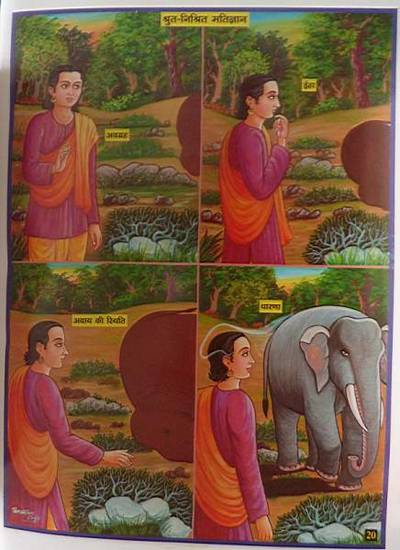
Stages of knowledge
Image by Diwakar Prakashan / Padma Prakashan © Diwakar Prakashan / Padma Prakashan
Samyag-jñāna comes second in the triplet because it relates to the intellectual understanding of an object viewed in its details. Literally ‘correct knowledge’, it means grasping properly the fundamental truths. For instance, the individual first recognises that there are living beings and non-living beings. Appreciating that they are very different, the individual then knows what is what. In short, correct knowledge means properly understanding the Jain view of the world, in all its elements, including the Jain universe – cosmology – and Jain history as viewed by the tradition, which is known as Universal History.
‘Correct faith’ may or may not exist, but knowledge or cognition of one form or the other always exists in a soul (Sukhlalji 1974: 18). Knowledge is an innate quality of the soul, but it is obscured by karmas until an advanced stage of spirituality.
Jains believe there are five types of knowledge. This table, based on page 112 of Wiley 2004, summarises the types of knowledge – jñāna.
|
|
Name |
Meaning |
Types of beings that have it |
|---|---|---|---|
|
1 |
sensory knowledge, coming from the five senses and the mind |
All living beings, even those that have only one sense, that of touch |
|
|
2 |
verbal cognition, implying language in gestures or words, especially knowledge of ‘what has been heard’. This means the tradition as handed down by the Jinas or scriptural knowledge |
Five-sensed beings with the ability to reason |
|
|
3 |
extrasensory knowledge or clairvoyance |
Beings that live in the heavens and hells are born with this but humans can gain it through specific practices |
|
|
4 |
knowledge of other’s minds or telepathy |
Human beings who are highly advanced spiritually |
|
|
5 |
omniscience or knowledge of everything everywhere, whether it relates to the past, present or future |
Right conduct
The final gem is samyak-cāritra. Once the essential truths are recognised and have been intellectually grasped, the time for action comes.
The notion of ‘right conduct’ relates to ethics and practice. It encompasses a large number of categories that define proper behaviour for Jain mendicants and lay people. Given the difference in their ways of life, it is to be expected that the prescriptions vary for these two groups.
Rules for mendicants
The table outlines the types of rules regulating the behaviour of mendicants.
|
Vows – vratas |
Precautions – samitis |
Protections – guptis |
|---|---|---|
|
five ‘great vows’ – mahā-vratas |
Relating to precautions when: |
Relating to activity of:
|
As well as taking five ‘absolute vows’, Jain mendicants should follow the precautions and protections. These two sets of rules are meant to reinforce self-control and, therefore, the mendicantlowers the risks of harming living beings. The rules thus contribute to non-violence – ahiṃsā – which is the first, most important mahā-vrata. Primarily, respecting these prescriptions helps to prevent the influx of new karmas – āsrava-nirodha or saṃvara – in the soul, which greatly aids spiritual progress. Related categories for mendicants are the:
- 22 torments – parīṣahas – which they have to conquer
- 12 topics of concentration – anuprekṣās – they must master.
Rules for lay people
The behaviour of lay Jains can also be regulated. Even though a ‘perfect lay Jain’ follows far fewer rules than a ‘perfect ascetic‘, the lay vows are challenging. The lay vows amount to 12 and comprise the:
- five ‘minor vows’ – aṇu-vratas – which are based on the ‘great vows’ of the mendicants
- three guṇa-vratas
- four śikṣā-vratas.
Each of the vows is supplemented by the description of possible transgressions – aticāras.
Order of the three gems
When they define the triplet, Jain authors insist on a certain sequence of the terms, which obeys logic and rationality. The standard order of the ‘three gems’ follows a process of understanding and action.
This is clearly stated in the Uttarādhyayana-sūtra:
There is no (right) conduct without right belief, and it must be cultivated (for obtaining) right faith; righteousness and conduct originate together, or righteousness precedes (conduct). Without (right) faith there is no (right) knowledge, without (right) knowledge there is no virtuous conduct, without virtues there is no deliverance, and without deliverance there is no perfection
chapter 28, verse 29 to 30
translation by Hermann Jacobi, 1895: 156
Thus the first element of samyag-darśana – ‘right faith’ or ‘right perception’ – refers to the initial act of accepting the doctrine in general.
‘Right knowledge’ – samyag-jñāna – is the second stage, where the follower understands the details of the principles.
‘Right conduct’ – samyak-cāritra – comes last as it refers to whatever relates to practice and ethics. It presupposes knowledge of the principles. For instance, the knowledge of what life is and how many organisms it includes is necessary to observe the vow of non-violence in all its aspects.
Variations in the sequence may arise for metrical reasons if the list takes place in a verse, like the passage from the Yoga-śāstra quoted above. In this verse, Hemacandra uses the variant śraddhāna – ‘belief’ – instead of the standard term darśana.
Unity of the three gems
The three gems can be thought of as summarising the steps towards liberation from the cycle of rebirths. The first gem is the vital first stage of the difficult spiritual path from total delusion towards self-realisation. The other two jewels constitute fundamental notions in later spiritual development. All stages of spirituality are defined in the guṇa-sthāna – 14 stages of spiritual progression.
Jains have always believed that spiritual development is completed in stages. Emancipation of the soul, which is the ultimate aim of Jainism, means destroying all the types of karmas that defile it. The karmas are hindrances to the attainment of omniscience – kevala-jñāna – and to the fulfilment of bliss. Karma is controlled and destroyed at successive levels of spirituality. There are no shortcuts to liberation, which lies at the end of an extremely long and challenging path. Even the Jinas travel this route, though they do it considerably quicker than other people. Because the three jewels together summarise the path, Jain teachers insist on the necessary association of the three gems.
Liberation is reached through the 14 stages of spiritual progression – the guṇa-sthāna. For instance, at the first and lowest stage, the soul is in a state of wrong perception or belief – mithyā-dr̥ṣṭi. The third stage – samyag-mithyātva – charts the journey between wrong belief and right belief. Right belief definitely comes in the fourth stage, called samyag-dr̥ṣṭi. The path to right knowledge and right conduct is traced in the rest of the 14 steps of the ‘scale of perfection’.
At the 13th stage, both belief – samyag-darśana – and knowledge – samyag-jñāna – are in their perfect form, yet this is not the stage of liberation because perfect conduct is not reached in the penultimate level. Perfect conduct is reached in the 14th stage, whereupon liberation – mokṣa – can take place. In this context, samyak-cāritra means both dispassion and total absence of activity (Sukhlalji 1974: 3).
The famous 20th-century Jain saint and philosopher Rājacandra expresses in the Gujarati-language Ātma-siddhi – Self-Realisation – the itinerary of someone aspiring to the realisation of the soul:
If such aspirants to soul-realisation get wise (guidance) of a True teacher, they acquire Right Belief [samakita, the Gujarati form of samyaktva = samyag-darśana], and lead a life of internal purification. He[,] who giving up bias for (one’s particular) school of thought and religion, follows the precept of the True Teacher, gets pure Right Belief. In it there is neither distinction nor party (or partisanship). (He) lives in the nature of one’s own self, believes in the experience (of one’s own realisation), is continuously attentive to one’s own inner nature – (such are the marks of one who has the) highest Right Belief. This Right Belief increasing, removes false belief. Then rises right conduct (cāritra), and the soul abides in or attains the dignity or status of non-attachment. Living in the perfect knowledge of the full nature of one’s self, this is called Perfect Knowledge (kevala-jñāna). (This is attained in human body and though) the body is retained, there is Liberation.
Ātma-siddhi, 109–113
translation by J. L. Jaini 1923: 88–91
The 18th-century Digambara mystical poet Dyānatrāy, on the other hand, explains how the triple gem itself is reached:
The auspicious gems
are god, scripture and guru.
They create the triple gem
of faith, knowledge and conduct.
Cort 2003: 289
Conventional and absolute viewpoints
The triplet is thus the means to reach liberation. In the tradition of thought that distinguishes a ‘conventional’ viewpoint and an ‘absolute’ viewpoint for each notion, it is restricted to a means.
The conventional viewpoint – vyavahāra-naya – stresses religious practices as a central part of spiritual practice whereas the absolute viewpoint – niścaya-naya – focuses on realising the soul directly, without rituals. The Digambara philosopher Kundakunda is the first to express this point clearly:
From the conventional viewpoint, conduct, faith and knowledge are indicated [as attributes] of the knower [= the soul]. But [from the absolute viewpoint] there is neither knowledge, nor conduct nor faith; the [soul as] knower is pure.
Samayasāra 1.7
translation by Nalini Balbir
A commentator on this verse explains it through a comparison. He says that fire is always one and the same, yet burning, cooking and shining are mentioned as its properties, in relation to different purposes or external factors. In the case of a complex reality such as the soul, the teacher distinguishes between its different characteristics in order to make the student understand what it is (Chakravarti 1971: 17).
Thus the triplet, consisting of three components, is an empirical conception – a ‘conventional’ view – while in the transcendental or ‘absolute’ conception, the soul is ultimately pure consciousness (Jainendra Siddhānta Kośa volume 3: 389 under ratnatraya).
Reading
- Samayasāra of Śrī Kundakunda
Kundakunda - translated by Appaswami Chakravarti
edited by A. N. Upadhye
Bhāratīya Jñānapītha Mūrtidevī Jaina granthamālā: English series; volume 1
Bhāratīya Jñānapīṭha; Banaras, Uttar Pradesh, India; 1971
- Jains in the World: Religious Values and Ideology in India
John E. Cort - Oxford University Press USA; New York, USA; 2001
- The Atma-Siddhi (or Self-Realisation) of Shrimad Rajchandra
Śrīmad Rājacandra - translated by Rai Bahadur J. L. Jaini
Shrimad Rajchandra Gyan Pracharak Trust; Ahmedabad, Gujarat, India; 1987
- Vrata-tithi-nirṇaya
Siṃhanandī - edited by Nemichandra Shastri
Jñānapīṭha-Mūrtidevī-Jaina-Granthamālā series; volume 19
Bhāratīya Jñānpīṭha; Kashi, Uttar Pradesh, India; 1956
- Commentary on Tattvārtha Sūtra of Vācaka Umāsvāti
Pandit Sukhlalji - translated by K. K. Dixit
L. D. series; volume 44
L. D. Institute of Indology; Ahmedabad, Gujarat, India; 1974
- Jaina Yoga: A Survey of the Mediaeval Śrāvakācāras
Robert Williams - London Oriental series; volume XIV
Oxford University Press; London, UK; 1963
- Historical Dictionary of Jainism
Kristi L. Wiley - Historical Dictionaries of Religions, Philosophies, and Movements series; series editor Jon Woronoff; volume 53
Scarecrow Press; Maryland, USA; 2004
Links
- Summary of the three gems
-
The Religions section on the BBC website provides an outline of the three gems of the Jain faith.
http://www.bbc.co.uk/religion/religions/jainism/beliefs/threejewels.shtml
- Jain doctrine
-
Jainworld.com gives a detailed explanation of key elements of Jain doctrine, including the:
- three gems
- concept of knowledge
- lay conduct
- vows
- penance.
- Holy symbols in worship
-
Taken from the side, this 2009 photo on Flickr captures a very holy and frequently found symbol in Jain worship. Created in rice grains as part of a ceremony, the symbol is in three parts. Considered from the bottom, they are:
- a svastika representing the four parts of the Jain community and four conditions of being
- three dots representing the three jewels of Jain doctrine
- a horizontal crescent with a dot above, which symbolises the liberated soul in the siddha-śilā.
- Explanations of Jain symbols
-
The website Namoka Tirth provides explanations for the common Jain symbols. Unexpectedly, this Digambara organisation offers the Śvetāmbara list of eight auspicious symbols.
Note that some of the website's assertions are not accepted by professional scholars because there is no indisputable historical proof. An example here is the dating of the first Jina, Ṛṣabha.
As with many Jain websites, the use of diacritics and transliterations here is inconsistent and does not meet academic standards.
- Elements of the Jain symbol
-
Jainworld.com describes the meaning of the different holy elements that make up the main Jain symbol.
- Introduction to Jainism – part 3
-
This extract from a BBC documentary on Jainism called The Frontiers of Peace explores the concept of renunciation. The video follows a young woman's decision to become a nun and a rich lay man's faith. The ritual of keśa-loca is filmed, in which monks and nuns pull out their hair. The lay man is shown making the auspicious symbols of the svastika, three dots representing the 'three jewels' of right insight, right knowledge and right conduct and the horizontal crescent of the siddha-śilā, where liberated souls live. This 2010 YouTube video is the third of four parts. See the next part at: http://www.youtube.com/watch?v=670KFhISeUk
eLibrary Links
- A Study of Tattvārtha-sūtra with Bhāṣya
- Volume 86 of the L. D. Series is an attempt to assess the date of the Tattvārtha-sūtra using its treatment of some doctrinal themes and references to external data. It seems reasonable to locate it in the 5th century CE. The differences between Digambara and Śvetāmbara versions of the text are also discussed, as well as the status of the Bhāṣya and the question of knowing whether it has the same author as the sūtra itself.
- +
- aAbhavya
- aAbhinandana
- aAbhiṣeka
- aĀcāra
- aĀcārāṅga-sūtra
- aĀcārya
- aAchalbhrata
- aAḍhāī-dvīpa
- aAdharma
- aAdho-loka
- aAdhyayana
- aAdvaita Vedānta
- aĀgama
- aAghātīya
- aAghātīya-karman
- aAgnibhuti
- aAgra
- aĀhāra
- aAhiṃsā
- aAhimsa Day
- aAjita
- aAjīva
- aAkampit
- aĀkāśa
- aAkbar the Great
- aAkṣaya-tṛtīyā
- aAlauddin Khalji
- aAlbert Einstein
- aAllah
- aAlms
- aĀlocanā
- aAloka-ākāśa
- aAmāri
- aAmbikā or Kūṣmāṇḍinī
- aAnagāra
- aAnanta
- aAnarthadaṇḍa
- aAnaśana
- aAnekānta-vāda
- aAṅga
- aAniconism
- aAnojjā
- aAntarāla
- aAntarāya-karma
- aAṇu
- aAṇu-vrata
- aAnukampā
- aAnuprekṣā
- aAnusvāra
- aApabhraṃśa
- aAparigraha
- aAra
- aĀrambha
- aĀrambhaja
- aĀratī
- aArdhamāgadhī Prākrit
- aArhaṃ
- aArhat
- aArśana-āvaraṇīya-karma
- aĀrta-dhyāna
- aĀryikā
- aĀryikā Jñānamati
- aĀśātanā
- aĀścarya
- aAscetic
- aAsceticism
- aAshram
- aAspiration
- aĀsrava
- aAṣṭa-maṅgala
- aAṣṭāpada
- aAstikāya
- aAstrolabe
- aAsura
- aAtheism
- aAticāra
- aAtiśayakṣetra
- aAtithisaṃvibhāgavrata
- aĀtma-vāda
- aĀtman
- aAuṃ
- aAurangzeb
- aAuspicious
- aAusterity
- aAvadhāna
- aAvadhi-jñāna
- aĀvaraṇī-yakarman
- aAvasarpiṇī
- aAvatāra
- aAvidyā
- aAxiom
- aĀyāga-paṭa
- aĀyambil
- aĀyu-karma
- aĀyurveda
- bBabur
- bBāhubali
- bBaladeva
- bBālāvabodha
- bBandha
- bBasadi
- bBazaar
- bBhadrankarvijay
- bBhagavant
- bBhaktāmara-stotra
- bBhakti
- bBhale
- bBharata
- bBhāṣā
- bBhāṣya
- bBhaṭṭāraka
- bBhāva
- bBhāva-pūjā
- bBhāvanā
- bBhavana-vāsin
- bBhavya
- bBhavyatva
- bBhaya
- bBhoga-bhūmi
- bBhogopabhoga
- bBodhi
- bBollywood
- bBrahmā
- bBrahma-deva
- bBrahmacārī
- bBrāhmaṇa
- bBraj Bhāṣā
- bBright fortnight
- bBritish Raj
- bBuddha
- bBuddhi-sagar
- bBuddhism
- bBuddhist
- cCaitya
- cCaityavāsin
- cCakravartin
- cCakreśvarī
- cCāmara
- cCandanā
- cCandragupta
- cCandraprabha
- cCanon
- cCāritra
- cCāritramohanīya-karman
- cCarũrī
- cCaste
- cCaturvidha-saṅgha
- cCaturviṃśati-stava
- cCāturyāma
- cCE
- cCelibacy
- cCha
- cChadmastha
- cChastity
- cCheda-sūtra
- cChristian
- cChristianity
- cClergy
- cCloning
- cColophon
- cCommentary
- cConch
- cConfession
- cCongregation
- cConsecration
- cCosmology
- cCremation
- cCrore
- cCult
- cCūrṇi
- dDādā-guru
- dDalit
- dDāna
- dDaṇḍa
- dDark fortnight
- dDarśana
- dDarśanamohanī-yakarman
- dDaśa-lakṣaṇa-parvan
- dDeity
- dDelhi Sultanate
- dDerāsar
- dDeśāvakāśika-vrata
- dDetachment
- dDevanāgarī
- dDevānandā
- dDevarddhi-gani
- dDevotee
- dDhamal
- dDhanuṣ
- dDhāra
- dDharma
- dDharma-dhyāna
- dDharma-sāgara
- dDharmastikaya
- dDhātakīkhaṇḍa
- dDholak
- dDhyāna
- dDiaspora
- dDig-vrata
- dDigambara
- dDīkṣā
- dDisciple
- dDīvālī
- dDivya-dhvani
- dDNA
- dDoctrine
- dDogma
- dDonor
- dDoṣa
- dDravya
- dDravya-pūjā
- dDrone
- dDuṣamā
- dDuṣamā-duṣamā
- dDuṣamā-suṣamā
- dDveṣa
- dDvīpa
- eEast India Company
- eEightfold Path
- eEkānta-vāda
- eEkendriya
- eElder
- eElders
- eEschatology
- eEtc up to
- fFarmān
- fFast
- fFatehpur Sikri
- fFestival
- fFestschrift
- fFiruz Shah
- fFly-Whisks
- fFolio
- fFour Noble Truths
- gGaccha
- gGaṇa
- gGaṇadhara
- gGanadharavada
- gGaṇeśa
- gGaṇin
- gGarba
- gGarbha
- gGarbha-gṛha
- gGaruḍa
- gGati
- gGene
- gGenomics
- gGhātī-yakarman
- gGhātīya
- gGhaznavid
- gGhiyasuddin Tughlaq
- gGhurid
- gGloss
- gGotra-karma
- gGujarāt
- gGujarati
- gGuṇa
- gGuṇa-sthāna
- gGuṇa-vrata
- gGupti
- gGuru
- gGuruṇī
- hHagiography
- hHajj
- hHaṃsa
- hHaribhadra
- hHariṇaigameṣin
- hHasta
- hHeresy
- hHiṃsā
- hHindi
- hHindu
- hHinduism
- hHīravijaya
- hHoroscope
- hHrīṃ
- hHumayun
- hHymn
- iIconoclasm
- iIconography
- iIdol
- iIndian Independence
- iIndology
- iIndra
- iIndrabhūti Gautama
- iIndriya
- iInitiation
- iIntercession
- iInvocation
- iIQ
- iIslam
- iIslamicate
- iIṣṭadevatā
- iĪśvara
- jJagat
- jJahangir
- jJain
- jJaina Devanāgarī
- jJaina Śaurasenī
- jJaina-dharma
- jJainaśāsana
- jJainness
- jJaisalmer
- jJamāli
- jJambū-dvīpa
- jJames Burgess
- jJanma
- jJanma-kalyāṇa
- jJarā
- jJāti
- jJina
- jJina-āgama
- jJina-bhavana
- jJina-bimba
- jJina-mātā
- jJinacandra-sūri
- jJinadatta
- jJinaprabha
- jJīva
- jJñāna
- jJñāna-āvaraṇīya-karma
- jJñāna-āvarṇiya
- jJñānsundar
- jJyotiṣka
- kKāla
- kKālakācārya-kathā
- kKālidāsa
- kKalpa-sūtra
- kKalpa-vṛkṣa
- kKalyāṇaka
- kKalyanvijay
- kKamaṇḍalu
- kKamaṭha
- kKarma
- kKarma-bhūmi
- kKarma-grantha
- kKarma-prakṛti
- kKarma-vāda
- kKarmon
- kKarnataka
- kKaṣāya
- kKathā
- kKāvya
- kKāya
- kKāyotsarga
- kKeśa-loca
- kKetu
- kKevala-jñāna
- kKevalin
- kKhalji
- kKharatara-gaccha
- kKnowledge
- kKriyā
- kKriyā-vāda
- kKṛṣṇa
- kKṣamā-śramaṇa
- kKṣapakaśreṇi
- kKṣatriya
- kKṣullaka
- kKulakara
- kKundakunda
- kKunthu
- lLabdhi
- lLaity
- lLakh
- lLāñchana
- lLands of Action
- lLaukāntika
- lLavaṇa-samudra
- lLeśyā
- lLiṅga
- lLinguistics
- lLoka
- lLoka-ākāśa
- lLoka-puruṣa
- lLoka-vāda
- lLotus
- lLotus lake
- mMadhya-loka
- mMahā-videha
- mMahā-vrata
- mMahābhārata
- mMahāmastakābhiṣeka
- mMāhārāṣṭra
- mMāhārāṣṭrī Prākrit
- mMahattarā Yākinī
- mMahāvīr Jayantī
- mMahāvīra
- mMakāra
- mMakkhali Gośāla
- mMalli
- mMāna-stambha
- mManaḥ-paryāya-jñāna
- mMaṇḍala
- mMaṇḍapa
- mMandit
- mMaṅgala
- mMantra
- mMantras
- mManuṣya-loka
- mMarāṭhī
- mMārgaṇā
- mMartyr
- mMarudevī
- mMaṭha
- mMati-jñāna
- mMauryaputra
- mMecca
- mMendicant lineage
- mMetarya
- mMiracle
- mMithyādṛṣṭi
- mMohandas Gandhi
- mMohanīya-karma
- mMokṣa
- mMonastic order
- mMonasticism
- mMonk
- mMonotheism
- mMosque
- mMount Meru
- mMount Sammeta
- mMṛgāvatī
- mMughal
- mMuhammad
- mMuhammad bin Tughlaq
- mMuhpattī
- mMūla-sūtra
- mMūlaguṇa
- mMumbaī
- mMuni
- mMunisuvrata
- mMurad Bakhsh
- mMūrti-pūjaka
- mMuslim
- mMysticism
- nNābhi
- nNāga-kal
- nNāgapurīya Tapā-gaccha
- nNāgarī
- nNāma-karma
- nNamaskāra-mantra
- nNami
- nNandīśvara-dvīpa
- nNandivardhana
- nNandyāvarta
- nNāraka
- nNāraki
- nNasalisation
- nNātha
- nNavrātrī
- nNaya-vāda
- nNemi
- nNidāna
- nniggaṃthāṇa vā 2
- nniggaṃtho vā 2
- nNigoda
- nNihnava
- nNikṣepa
- nNirgrantha
- nNirjarā
- nNirvāṇa
- nNiryukti
- nNiṣidhi
- nNitya
- nNiyati
- nNo-kaṣāya
- nNudity
- nNun
- oOcean of milk
- oOmniscience
- oOrdination
- ppa°
- pPadmaprabha
- pPadmāsana
- pPadmāvatī
- pPādukā
- pPalanquin
- pPalette
- pPañca-muṣṭi
- pPāṇḍava
- pPaṇḍit
- pPandit Dalsukh D. Malvania
- pPandit Sukhlalji
- pPāṇipātra
- pPāpa
- pParamātman
- pParameṣṭhin
- pPāraṇā
- pParigraha
- pPariṇāma
- pParīṣaha
- pParokṣa
- pPārśva
- pPārśvanātha
- pParyāya
- pParyuṣaṇ
- pPaṭa
- pPatan
- pPātra
- pPenance
- pPersian
- pPhala
- pPhilology
- pPicchikā
- pPilgrimage
- pPīr
- pPolymath
- pPoṣadha
- pPossession
- pPothī
- pPrabhas
- pPradakṣiṇā
- pPradeśa
- pPrākāra
- pPrakīrṇaka-sūtra
- pPrākrit
- pPramāda
- pPramukhā
- pPrati-vāsudeva
- pPratikramaṇa
- pPratimā
- pPratiṣṭhā
- pPratyākhyāna
- pPratyakṣa
- pPravacana
- pPrāyaścitta
- pPrayer
- pPre-modern
- pPreach
- pPredestination
- pProtestant
- pProvenance
- pPudgala
- pPūjā
- pPujārī
- pPukharavara-dvīpa
- pPuṇya
- pPūrva
- pPuṣkara-dvīpa
- pPuṣpadanta
- pPyre
- qQur’an
- rRāga
- rRāhu
- rRainy season
- rRajasthan
- rRajasthani
- rRājimatī
- rRajoharaṇa
- rRajput
- rRāma
- rRāmāyaṇa
- rRangoli
- rRās-garbā
- rRasa
- rRathanemi
- rRatna-traya
- rRātri-bhojana
- rRaudra-dhyāna
- rRecto
- rRelic
- rRenunciation
- rRetroflex
- rRevatī
- %Ṛg-veda
- rRite
- rRosary
- %Ṛṣabha
- %Ṛṣabhanātha
- rRupee
- sSaciyā Mātā
- sSādhu
- sSādhvī
- sSāgāra
- sSaint
- sŚaivaism
- sŚaka-saṃvat
- sSallekhanā
- sŚalya
- sSamacatuṣṭha
- sSamādhimaraṇa
- sSamaṇi
- sSāmarambha
- sSamavasaraṇa
- sSāmāyika
- sSaṃbhava
- sSamiti
- sSaṃjñā
- sSaṃkalpaja
- sSaṃsāra
- sSamudghāta
- sSaṃvara
- sSaṃvega
- sSamyak-cāritra
- sSamyak-darśana
- sSamyak-jñāna
- sSamyaktva
- sSaṃyama
- sSanctuary
- sSandalwood
- sSaṇgha
- sSanskrit
- sSant
- sŚānti
- sSapta-bhaṅgi-naya
- sSārambha
- sSarasvatī
- sSarvajña
- sSāsan-devi
- sŚāsana-devatā
- sŚāstra
- %Ṣaṭ-jīvanikāya
- sSatī
- sSatīmātā
- sSatya
- sSchism
- sScribe
- sScripture
- sSect
- sSecularism
- sŚenāī
- sSermon
- sŚeṣavatī
- sSevā
- sSeven fields of donation
- sShah Jahan
- sShantidas Jhaveri
- sShrine
- sSiddha
- sSiddha-śilā
- sSiddhacakra or Navadevatā
- sSiddhānta
- sSiddhārtha
- sSiddhi
- sSikh
- sSikhism
- sŚikṣā-vrata
- sŚīla
- sSin
- sSindh
- sŚītala
- sŚiva
- sSkandha
- sSomanatha
- sŚraddhā
- sŚramaṇa
- sŚrāvaka
- sŚrāvakācāra
- sŚrāvikā
- sŚreyāṃsa
- sŚrī
- sŚrīvatsa
- sŚruta-jñāna
- sŚruta-pañcamī
- sSthānaka-vāsin
- sSthāpanācārya
- sSthāvara
- sSthavira
- sSthiti
- sStrīmukti
- sStūpa
- sSubcontinent
- sSudarshana
- sŚuddhi
- sSudharma
- sŚūdra
- sSufism
- sSukha
- sŚukla-dhyāna
- sSulasā
- sSultan
- sSumati
- sSundarśrī
- sSupārśva
- sSūri
- sSuṣamā
- sSuṣamā-duṣamā
- sSuṣamā-suṣamā
- sSūtra
- sSuyam me ausam! Tenam bhagavaya evamakkhayam
- sSvādhyāya
- sSvāhā
- sSvastika
- sŚvetāmbara
- sŚvetāmbara Terāpanthin
- sŚvetāmbaras
- sSwan
- sSyād-vāda
- tTabla
- tTantra
- tTapā-gaccha
- tTapas
- tTāraṇ Svāmī Panth
- tTattva
- tTattvārtha-sūtra
- tTemple
- tTemple-city
- tThe Enlightenment
- tTheology
- tThree worlds
- %Ṭīkā
- tTilaka
- tTīrtha
- tTīrthaṃkaranāma-karman
- tTīrthankara
- tTransliteration
- tTrasa
- tTrasa-nāḍī
- tTriśalā
- tTriṣaṣṭi-śalākā-puruṣa-caritra
- tTti bemi
- tTughlaq
- tTunk
- uUdumbara
- uUniversal History
- uUpādhyāya
- uUpāṅga
- uUpaniṣads
- uUpāsaka
- uUpasarga
- uUpāśraya
- uŪrdhva-loka
- uUtsarpiṇī
- uUttarādhyayana-sūtra
- vVāhana
- vVaimānika
- vVairāgya
- vVaiṣṇava
- vVaiśramaṇa
- vVaiśya
- vValabhī
- vVanaspatikāya
- vVandana
- vVaṇik
- vVarṇa
- vVāsudeva
- vVāsupūjya
- vVayubhūti
- vVeda
- vVedanīya-karma
- vVegetarianism
- vVehicle
- vVernacular
- vVerso
- vVidyā
- vVidyā-devī
- vVihāra
- vVijñapti-patra
- vVikrama-saṃvat
- vVikṛti
- vVimala
- vVinaya
- vVipāka
- vVirji Vora
- vVirodhaja
- vVīrya
- vVisarga
- vViṣṇu
- vVītarāga
- vVizier
- vVotive
- vVow
- vVrata
- vVS
- vVyakta
- vVyantara
- vVyasana
- yYakṣa
- yYakṣī
- yYantra
- yYaśoda
- yYaśovijaya
- yYati
- yYātrā
- yYoga
- yYoginī
- yYojana


